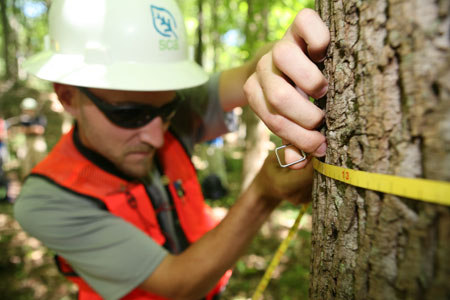By Tacy Lambiase
Look out, big trees: Today, there are some new champions in town.
More than 40 new trees were declared the biggest of their species today with the release of American Forests’ National Register of Big Trees, which contains a total of almost 780 national champion and co-champion trees. The register, which is updated twice per year, records the largest trees of each species in the United States based on height, circumference and average crown spread.

While some new trees have been added to this spring’s register, others have been “dethroned” of their reign as champion trees. Here are some of the champions making headlines:
- Oregon has 26 national champion trees, with newcomers including a ponderosa pine and blue-myrtle blueblossom.
- Two co-champion palm coconut trees in Hawaii have been dethroned by a bigger palm, also located in Hawaii.
- Texas moves into second place, overtaking Arizona, with 90 national champions, including co-champion anacua trees, nutmeg hickory, delta post oak and mescalbean sophora, and Florida remains the state with the most national champions.
- Kentucky has a new co-champion American basswood. The tree is located next to Henry Clay’s tomb in historic Lexington Cemetery.
- Unfortunately, six of South Carolina’s national champion trees have been dethroned due to the “10-year rule.” Trees that have not been re-measured in the last 10 years are removed from the register, as the trees need to be checked to confirm their health and condition.
While it’s always a little sad to see some our favorite big trees dethroned, it doesn’t mean that these magnificent trees can’t be recognized and appreciated in other ways. In fact, American Forests has developed an all-new Tree Protection Toolkit to provide advice and guidance about how you can preserve historic trees in your own backyard.

Sometimes, prized trees in yards, neighborhoods, communities or even national forests find themselves in danger from diseases, pests, storms and — too often — the consequences of living alongside humans. Unlike most things, which depreciate with age, trees appreciate in value over time and provide more benefits as they get older, which is why it’s important to protect treasured trees from destruction. The information compiled in the toolkit can help you determine why a particular tree is threatened, find out which departments within your municipality are responsible for handling tree and land-use issues, calculate the value of your tree, and so much more.
Already know of a tree worth preserving? Learn more about American Forests’ Big Tree program, view the National Register of Big Trees or consult the Tree Protection Toolkit!